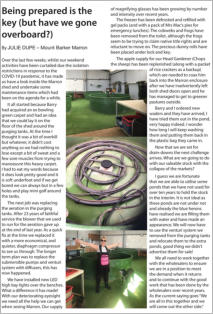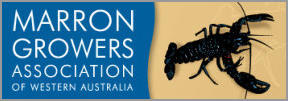
© Copyright The Marron Growers Association of WA 2024
Working Hard for Western
Australian Marron
Growers
The Marron Growers Bulletin
Free to all members.
Full of interesting & informative articles, the Bulletin is an essential magazine for all marron growers. Below we publish a selection of past articles so that you can see the quality & scope of the information the Bulletin contains. If you would like to know more or join the Marron Growers Association of WA, please contact us or download & submit our Membership Application form

Those of you who have attended a number of field days will recall listening to people in the know talk about pond preparation. Likewise, if you have done any
of your own research into the world of pond aquaculture you may have come across this topic. it is a crucial step in the production cycle which sets the
building blocks for the rest of your production season. What we do to a pond before we put stock in it should be seen in the same light as what we do to a hay
paddock prior to locking it up for the season. For the most part, the standard procedure for pond preparation is not all that practical when it comes to semi-
intensive Marron farming. Most aquaculture texts will tell you something along the lines of, drain pond, wash pond, allow to dry for around a week, test soil pH,
apply required amount of lime, fill pond. Then there’s the step about how much fertiliser to apply to achieve a healthy plankton bloom to maximise production.
Trouble is, when you drain a pond in the middle of winter it may be nearly impossible to keep it dry (or empty in some cases), it may be also impossible to
leave it empty for a week, given that draining one pond general creates the need for two empty ponds. For those of you considering building drainable ponds i
cannot overstate the importance of being able to completely self drain them. As someone who has to deal with 15 ponds most of which require at least some
pumping, it creates a serious draw on your time and energy.
There is no doubt that ponds do benefit from some drying time. Even the simple act of leaving them empty overnight after washing will see a noticeable
change in colour in the residual mud from a grey/black colour to a much healthier looking brown colour. Leaving ponds empty allows sediments to oxidise and
exposure to UV rays will kill off undesirable bacteria in your ponds. As far as textbook theories on fertilising go, most of these strategies rely on the required
amount of warmth and sunlight being available at the time of filling. Generally speaking, throughout most of Marron country, applying inorganic fertilisers to
ponds during the draindown season will do nothing as temperature and sunlight are insufficient to promote good primary productivity.
At Blue Ridge, we generally have a few instances each year where ponds become inundated with aquatic weed. in extreme cases, as shown in Figure 1 , the
entire base and banks of a pond may become completely covered in weed. i don’t think the weed is altogether bad for production, in particular where
juvenile marron are concerned, the right amount of the right kind of weed can be quite beneficial. This year we drained a breeding pond where we
struggled to find a single juvenile on any of the hides, we drained the pond expecting we might find a couple of thousand and ended up with about
8,000 beautiful big juveniles. Where juveniles are concerned i expect that some weeds not only provide good complex habitat but a great food
source for the juveniles, not so much the weed itself but the food chain which establishes on the surface of the weed. The types of aquatic weed we most
regularly encounter don’t necessarily pose too much of a problem with the actual drain down itself. The Marron don’t tend to get stuck in the weed as one
might think. For the most part, both big and small Marron will climb up and out of it when the time is right. it does, however, pose a problem when trying to
clean the pond out as the weed obviously stops the washed sediment from flowing towards the outlet of the pond. it also creates a barrier between the
atmosphere and the pond sediment preventing the pond from ‘airing out’. As can be seen in Figure 2, one method we have used is to allow the weed to die off
a bit, rake it into rows (yes… by hand) so that the pond can be cleaned, wash the pond out and then spread some hydrated lime on the piles of weed to try and
kill it off and aid in its decomposition.
This year we have also applied a couple of small bales of barley straw to the bottoms of all ponds prior to refilling. Having encountered a few problems with
filamentous algae during the springtime in recent years we have used a fair bit of barley straw extract with mostly good results. We are working on the premise
that when the barley straw is added in a reasonable quantity it does add a nice tanniny colour to the water, working along the same lines as some of John’s
theories, if the breakdown of the barley straw boosts the carbon levels in the water then this should favour the bacteria in the pond rather than the growth of
filamentous algae. Figure 3 shows one of our most problematic ponds after draining. We had all sorts of filamentous algae growing throughout the whole
summer and no amount of barley straw seemed to have any effect. Figure 4 shows the same pond after washing with barley straw added to the base of the
pond.i had been interested in the reports coming back from John’s trip to Redclaw country about the use of Lucerne hay, maybe this works in a similar fashion.
in our situation, because we grow trout in the dams which supply the Marron ponds i was hesitant to add any more nitrogen to water, given that Lucerne is
much higher in protein than barley straw. Though it is still pretty early in the production season, all the ponds treated with barley straw seemed to be ticking
along pretty good so far, with no major algal problems to date. Upon draining last year, none of the ponds we had treated with barley straw had any left-over
straw in the bottom of the ponds so the Marron must also utilise it as an additional food source. i guess by this time next year we will know if it is a good idea
or not.
Preparation is the Key
By Steve Vidovich
If you would like to order a Marron Growers magazine or back issue, please contact us.

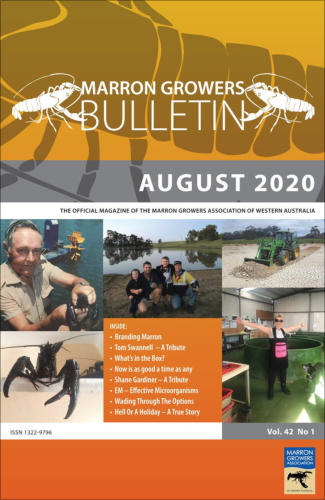
The Marron Growers Bulletin has been a regular part of our members lives since 1978.
Packed full of interesting articles and photographs, it brings together the latest news for all
WA marron farmers.
We have a range of options for advertising with us, current prices are available from the
Association Secretary, you can discuss your business needs & we’ll help identify the best way
for you to advertise with us and make the most of your budget.
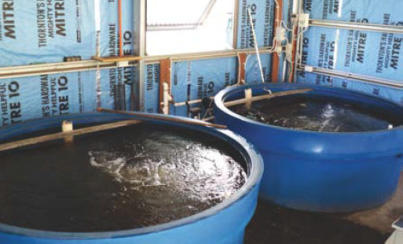


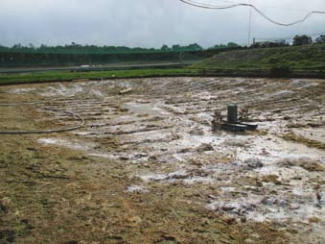
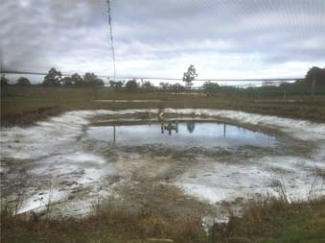
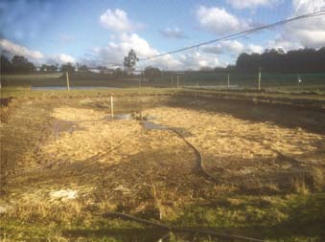
Figure 2: a weedy pond, allowed to dry, weed then raked
into rows for washing and hydrated lime added.
Figure 1: a weedy pond about a week after draining. Weed
on the banks is dying off but, beneath the crust on the top
is still very much alive. This pond still produced around
300kg of 1+.
Figure 4. The same pond after washing with barley
straw added to the base.
Figure 3. One of our worst producing ponds coated in
hydrated lime prior to washing and drying.
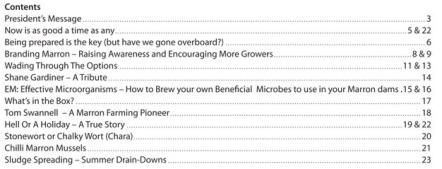

© Copyright The Marron Growers Association of WA 2024
Working Hard for
Western Australian
Marron Growers
The Marron
Growers Bulletin
Free to all members.
Full of interesting & informative articles, the Bulletin is an essential magazine for all marron growers. Below we publish a selection of past articles so that you can see the quality & scope of the information the Bulletin contains. If you would like to know more or join the Marron Growers Association of WA, please contact us or download & submit our Membership Application form

Those of you who have attended a number of field days
will recall listening to people in the know talk about pond
preparation. Likewise, if you have done any of your own
research into the world of pond aquaculture you may
have come across this topic. it is a crucial step in the
production cycle which sets the building blocks for the
rest of your production season. What we do to a pond
before we put stock in it should be seen in the same light
as what we do to a hay paddock prior to locking it up for
the season. For the most part, the standard procedure for
pond preparation is not all that practical when it comes to
semi-intensive Marron farming. Most aquaculture texts
will tell you something along the lines of, drain pond,
wash pond, allow to dry for around a week, test soil pH,
apply required amount of lime, fill pond. Then there’s the
step about how much fertiliser to apply to achieve a
healthy plankton bloom to maximise production.
Trouble is, when you drain a pond in the middle of winter
it may be nearly impossible to keep it dry (or empty in
some cases), it may be also impossible to leave it empty
for a week, given that draining one pond general creates
the need for two empty ponds. For those of you
considering building drainable ponds i cannot overstate
the importance of being able to completely self drain
them. As someone who has to deal with 15 ponds most of
which require at least some pumping, it creates a serious
draw on your time and energy.
There is no doubt that ponds do benefit from some
drying time. Even the simple act of leaving them empty
overnight after washing will see a noticeable change in
colour in the residual mud from a grey/black colour to a
much healthier looking brown colour. Leaving ponds
empty allows sediments to oxidise and exposure to UV
rays will kill off undesirable bacteria in your ponds. As far
as textbook theories on fertilising go, most of these
strategies rely on the required amount of warmth and
sunlight being available at the time of filling. Generally
speaking, throughout most of Marron country, applying
inorganic fertilisers to
ponds during the draindown season will do nothing as
temperature and sunlight are insufficient to promote
good primary productivity.
At Blue Ridge, we generally have a few instances each
year where ponds become inundated with aquatic weed.
in extreme cases, as shown in Figure 1 , the entire base
and banks of a pond may become completely covered in
weed. i don’t think the weed is altogether bad for
production, in particular where
juvenile marron are concerned, the right amount of the
right kind of weed can be quite beneficial. This year we
drained a breeding pond where we
struggled to find a single juvenile on any of the hides, we
drained the pond expecting we might find a couple of
thousand and ended up with about
8,000 beautiful big juveniles. Where juveniles are
concerned i expect that some weeds not only provide
good complex habitat but a great food
source for the juveniles, not so much the weed itself but
the food chain which establishes on the surface of the
weed. The types of aquatic weed we most regularly
encounter don’t necessarily pose too much of a problem
with the actual drain down itself. The Marron don’t tend
to get stuck in the weed as one might think. For the most
part, both big and small Marron will climb up and out of
it when the time is right. it does, however, pose a problem
when trying to clean the pond out as the weed obviously
stops the washed sediment from flowing towards the
outlet of the pond. it also creates a barrier between the
atmosphere and the pond sediment preventing the pond
from ‘airing out’. As can be seen in Figure 2, one method
we have used is to allow the weed to die off a bit, rake it
into rows (yes… by hand) so that the pond can be cleaned,
wash the pond out and then spread some hydrated lime
on the piles of weed to try and kill it off and aid in its
decomposition.
This year we have also applied a couple of small bales of
barley straw to the bottoms of all ponds prior to refilling.
Having encountered a few problems with filamentous
algae during the springtime in recent years we have used
a fair bit of barley straw extract with mostly good results.
We are working on the premise that when the barley
straw is added in a reasonable quantity it does add a nice
tanniny colour to the water, working along the same lines
as some of John’s theories, if the breakdown of the barley
straw boosts the carbon levels in the water then this
should favour the bacteria in the pond rather than the
growth of filamentous algae. Figure 3 shows one of our
most problematic ponds after draining. We had all sorts
of filamentous algae growing throughout the whole
summer and no amount of barley straw seemed to have
any effect. Figure 4 shows the same pond after washing
with barley straw added to the base of the pond.i had
been interested in the reports coming back from John’s
trip to Redclaw country about the use of Lucerne hay,
maybe this works in a similar fashion.
in our situation, because we grow trout in the dams which
supply the Marron ponds i was hesitant to add any more
nitrogen to water, given that Lucerne is
much higher in protein than barley straw. Though it is still
pretty early in the production season, all the ponds
treated with barley straw seemed to be ticking along
pretty good so far, with no major algal problems to date.
Upon draining last year, none of the ponds we had
treated with barley straw had any left-over straw in the
bottom of the ponds so the Marron must also utilise it as
an additional food source. i guess by this time next year
we will know if it is a good idea or not.
Preparation is the Key
By Steve Vidovich
If you would like to order a Marron Growers
magazine or back issue, please contact us.




Figure 2: a weedy pond, allowed to dry,
weed then raked into rows for washing and
hydrated lime added.
Figure 1: a weedy pond about a week after
draining. Weed on the banks is dying off
but, beneath the crust on the top is still
very much alive. This pond still produced
around 300kg of 1+.
Figure 4. The same pond after washing
with barley straw added to the base.
Figure 3. One of our worst producing
ponds coated in hydrated lime prior to
washing and drying.

